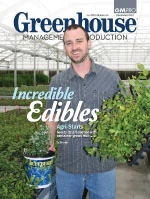 These days, everyone’s interested in being “green” or, even better, sustainable. Growing media is no exception. While many growers may just be starting to pay attention to parboiled rice hulls (PBH) as an alternative to perlite, it’s not a new topic to most. Since the 1970s, rice hulls in some form or another (composted, aged, etc.) have been used in commercial production or growing media trials as an alternative to peat and peat/perlite mixes.
These days, everyone’s interested in being “green” or, even better, sustainable. Growing media is no exception. While many growers may just be starting to pay attention to parboiled rice hulls (PBH) as an alternative to perlite, it’s not a new topic to most. Since the 1970s, rice hulls in some form or another (composted, aged, etc.) have been used in commercial production or growing media trials as an alternative to peat and peat/perlite mixes.
Rice hulls introduction
Mark Shepherd, eastern marketing manager with Riceland Foods headquartered in Stuttgart, Ark., said that PBH are generally less expensive than perlite (up to 50 cents less per cubic foot depending on freight). The company introduced its PBH product at the 2005 OFA Short Course.
The rice hulls are generated from an average annual 100 million bushels of rice grown by 7,500+ farmers in Arkansas, Louisiana, Missouri and Texas. There are approximately 2.5 million acres of rice grown in this region annually, which generates enough PBH to cover the volume of perlite used in today’s horticultural production.
PBH considerations
PBH are consistent in size and shape. The hulls increase air pore space and porosity in growing media. They also have a slightly higher water-holding capacity than perlite in instances where less than 20 percent of the mix consists of the hulls. PBH have no significant nitrogen tie-up, are OMRI approved and are a completely renewable, sustainable product.
One key advantage of PBH is that they have been sterilized and are free of viable weed-seed. Perlite and PBH produce comparable plant growing results and root systems in side-by-side trials up to a 30 percent PBH mix component.
A PBH disadvantage that cannot be overcome is their shape. PBH resemble the shape of a tiny canoe with a long slender pore shape. If a growing mix’s other components are poor quality, such as a peat with a lot of fines, these fines can fill the PBH pore space and actually hinder drainage and increase the water holding capacity of a mix.
A growing mix is only as a good as its components. PBH cannot work independently of the other mix components. The highest quality PBH are no match for a mix composed of poor quality peat, bark fines and other materials that are commonly available. Quality raw materials at their earliest stages lay the foundation for growing success.
Using PBH may cause growers to change the way they water their plants. PBH can cause a growing mix to appear dry on the surface. This perception has tricked many greenhouse workers to water the medium too early. Some adjustment and adapting of water practices and schedules are often in order when using PBH.
Growers considering incorporating PBH as a component in their mix or using a PBH-containing mix should closely test and evaluate the quality of the product.
Continued use of perlite
The Perlite Institute, founded in 1949, reports the demand for perlite continues to be high and the supply is plentiful. It has been mined and used in growing mixes for over 60 years. Outside the horticulture industry, perlite is used as a filter aid in water and pharmaceutical purification and other government approved uses.
Perlite is sterile, lightweight and safe to handle. As a growing media component, perlite has a neutral pH, does not deteriorate and improves a mix’s porosity and water-holding capacity. It helps to provide moisture and nutrients to the plant roots.
Steve Jarahian is director of technical services and quality control, Oldcastle Lawn & Garden Inc.; (864) 617-4057; steve.jarahian@oldcastleapg.com; www.jollygardener.com.

Explore the December 2010 Issue
Check out more from this issue and find your next story to read.
Latest from Greenhouse Management
- Anthura acquires Bromelia assets from Corn. Bak in Netherlands
- Top 10 stories for National Poinsettia Day
- Langendoen Mechanical hosts open house to showcase new greenhouse build
- Conor Foy joins EHR's national sales team
- Pantone announces its 2026 Color of the Year
- Syngenta granted federal registration for Trefinti nematicide/fungicide in ornamental market
- A legacy of influence
- HILA 2025 video highlights: John Gaydos of Proven Winners





